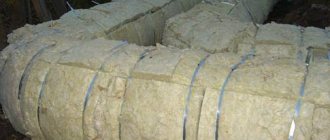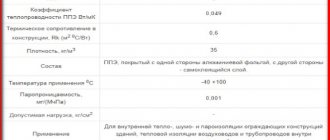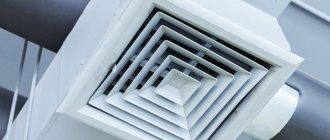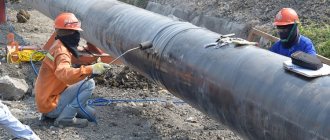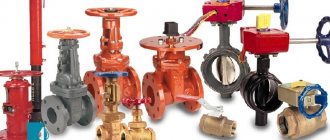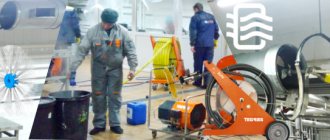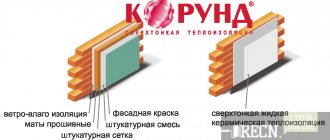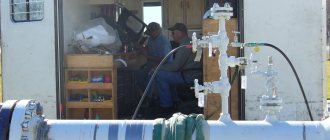Any building must ensure the maximum safety of the people in it. One of the most dangerous situations is a fire. The spread of fire between floors occurs most often through the ventilation system, and therefore the problem of fire resistance of air ducts is one of the most urgent tasks of fire prevention.
We welcome our regular reader and offer him an article on what air duct fire protection is, why it is needed and how it is performed.
What is
Fire protection for air ducts is a passive means of protection against fire and consists in creating a heat-insulating protection (screen) on the surface of ventilation pipelines with high heat and fire resistance.
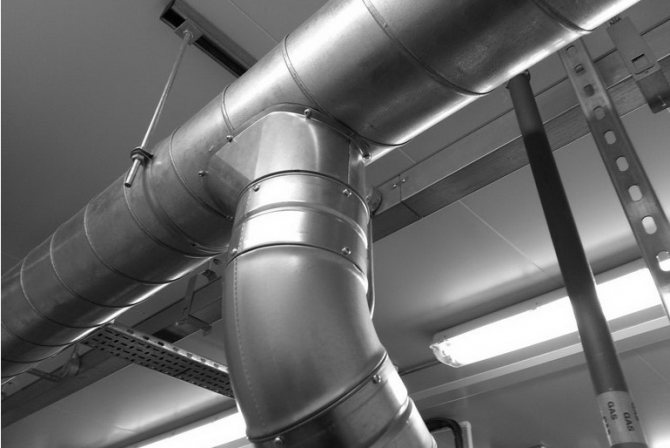
The screen must, for a specified time, protect:
- near sources of ignition - an air duct from destruction and, if possible, from heating;
- in the above and below rooms, walls, ceilings - combustible structures and materials adjacent to the air duct pipes, from secondary combustion.
Fire protection is carried out by applying special compounds or thermal insulation with various products made of non-combustible materials (mineral wool, asbestos, sometimes ceramic materials - for example, expanded clay concrete, brick).
Soundproofing device for air ducts
Ventilation system parts can generate unwanted noise, from which it is necessary to protect the ventilated areas of the building. The main noise generator is the fan blades. In addition to the main ones, there are additional sources of sounds: dampers, valves, other mechanisms with rotating elements. The intrinsic turbulence of the flow can also create noise and, in addition, provoke resonant vibrations. Such turbulent flows appear in places where the direction and cross-section of air ducts change.
To prevent flue gas leakage and damage to building components of the dwelling to avoid excessively rapid cooling of flue gases, which will lead to excessive condensation in the duct, resulting in poor flushing and living environment. For fire behavior of insulation materials, we work in Europe with a European class system. It shows how flammable the material is.
Explanation of European Classes
Insulation panels are non-smoking and do not work. The same cannot be said for many other materials. The system has two defects that make it difficult to apply to insulating materials. Products covered with a thin layer of flammable surface are penalized. Finish coatings have an impact on a European grade system, but have a limited impact on the risk of fire in a building. This is due to the fact that the flammable mass is reduced in relation to the mass of other materials in the product.
Some of the noise and vibrations can be eliminated due to the properties of the material from which the duct is made. This function is most effectively performed by flexible hoses, partially by ventilation ducts made of polymer materials. Noise and vibrations are most pronounced through metal ducts. Therefore, with increased requirements for the noise level in the room, a noise insulation device is necessary. In some cases, an acceptable solution is to install duct mufflers.
The system is only intended for checking and evaluating wall and ceiling coverage. Classifications are assigned to a bare product or application.However, insulating materials are rarely used naked. They are located behind another layer, such as drywall. This is why the European class for bare insulating materials is less relevant. "Applied" classifications are used to compare insulation materials.
The included waterproof film ensures that the panels are watertight, and the wide range of technical solutions and elements allows you to creatively adapt to any need. Waterproofing Effective fire protection High quality thermal insulation Fast and simple construction High load capacity Long service life Ease of use Versatile use Long service life. These 3 coatings form a "sandwich" compact element that provides the required flow, sealing and assembly, while the non-combustible mineral wool core guarantees excellent thermal insulation beyond the high fire resistance.
The ideal option for organizing a soundproofing layer, due to the fibrous structure and optimal density, is the use of insulation based on basalt or fiberglass.
Noise reduction can be achieved with specially coated boards made of fiberglass non-woven fabric or fiberglass. Such plates are installed inside the duct, the joints are closed with a metal profile.
All protective openings are also protected with this waterproofing film. Examples of shapes Internal cladding: always trapezoidal. Exterior decoration: Scale. A waterproof film is applied to these covered roof panels to ensure that the roof is waterproof.
Accessories We offer a wide range of solutions for skylights and other types of glazed surfaces. We also integrate wolf wings, fans, chimneys and other technological solutions. Exceptional dimmer, excellent insulator, does not absorb water, resists compression and is easy to apply, greatly reducing commissioning time.
Why ventilation is dangerous during a fire
The ventilation system in the event of a fire creates two types of danger:
- distribution of smoky air through the air ducts. The uninitiated people underestimate the danger of smoke - and according to statistics, most of those injured and killed during the fire died of suffocation. But this article will not talk about the prevention of smoke;
- spread of fire and secondary ignition of combustible structures and materials from contact with the hot walls of the air duct.
In most public, industrial and office buildings, natural ventilation is used (that is, without the use of fans) or mixed (some of the systems are equipped with fans). In private and apartment buildings, only natural ventilation is usually used.


The air ducts of any ventilation system are practically not blocked by any valves and gates (in modern systems, special fire dampers are installed, but there is always a possibility that the valves will not work, and modern systems are not installed everywhere).
In large modern buildings, there are smoke removal systems - separate exhaust ventilation removes combustion products from places of fire and from adjacent rooms, supply ventilation pumps air and creates excess pressure in staircases and elevator shafts and prevents them from smoke.
Hot air from the fire zone will rush upward, heat the air ducts, carry away sparks and flames - and cause secondary fires on the upper floors, attics, and roofs.
Which premises need protection in the first place
First of all, they need fire protection:
- warehouses of fuels and lubricants;
- production using open fire or molten metals and minerals, welding, plasma cutting, electric furnaces for various purposes;
- places with a large crowd of people - shopping centers, shops; entertainment establishments (theaters, cinemas, entertainment complexes, sports facilities); office buildings, household buildings in industrial enterprises, children's and educational institutions; catering establishments4
- underground structures.
At the household level, first of all, they need to protect the premises with heating devices (especially with the use of open fire) - rooms with stoves and fireplaces, baths, kitchens, boiler rooms and the premises and attics located above them. However, all air vents should be protected - fires occur for other reasons (cigarettes, pranks, short circuits).
Do not forget about high-quality and correct thermal insulation and sufficient fire resistance of chimneys, especially in places of passage through walls, ceilings and roofs.
Methods and materials for protection
Fire protection methods:
- insulation using sheet and roll materials made of mineral wool;
- application of special intumescent paints;
- application of refractory mastics;
- device of a fire-retardant barrier made of heat insulators;
- combined method - the use of paints and roll materials.
For the fire protection of a forced ventilation system (using a fan), vibration-resistant soundproof materials are required, since the ventilation units generate noise and vibration.
The thickness of the metal for ventilation ducts must be at least 0.8 mm; grilles and diffusers in the system must be installed in metal.
Basalt mats, slabs, sheets
For fire protection, mats and sheets of mineral wool, vermiculite boards, foil sheets, self-adhesive basalt fibers, asbestos-cement, gypsum fiber boards are used. Medium in price and affordable for self-assembly method of isolation. For installation, use screws, washers, pins, wire, clamps. They increase the dimensions and weight of the pipes, it is impossible to carry out work if the pipe is tightly adjacent to the wall or located in a corner. There are a lot of types and varieties of plates and mats.
Fire retardant paint
Special paints, varnishes and enamels are used that swell under the influence of high temperatures. The resulting layer has high thermal insulation properties.
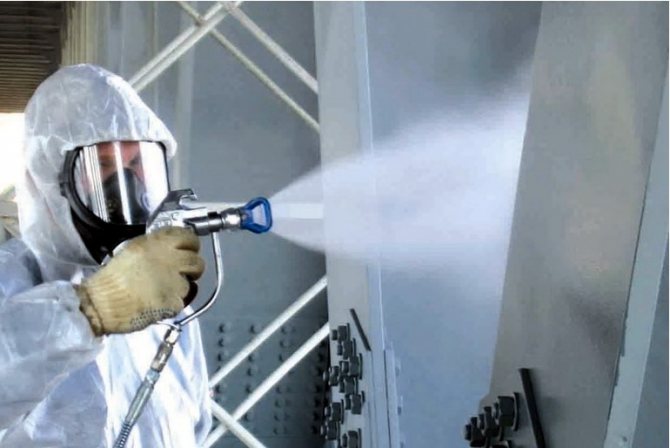

Easy and quick to apply. It can be applied in hard-to-reach places, where thicker insulation does not fit - for example, if the pipes are laid against the wall and in the corner of the room. The complexity of this method is about 5 times less than the use of mineral mats or mastics. Disadvantages: Less effective thermal insulation than other methods. Most of the compositions are of considerable value.
Fire barrier
To create a fire barrier, plaster on a grid, a brick box or concrete coating are used. These methods are already unpopular. Plaster makes the structure very heavy, requires strengthening of fasteners. Brick boxes are sometimes used in private housing construction.
Concreting used to be used in the construction of industrial and residential buildings, now it is practically not used.
For concrete and brick boxes, a foundation is required.
Refractory mastic
All kinds of pastes and mastics based on phosphates, liquid glass (silicates), mineral or asbestos fibers, nepheline mineral are applied in a thick layer to the surface of the air ducts. Coating thickness - from 10 to 50 mm. An effective method of fire protection, moreover, inexpensive and fairly easy and with not too much labor costs.


The application of pastes requires the use of specialized equipment available only to organizations.The coating is unstable to moisture and precipitation - the wet layer cracks during temperature changes. Significantly increase the mass of structures and require reinforcement of fasteners. Do not coat the walls of air ducts adjacent to walls.
Where to buy materials
Your life and the life of your loved ones depend on the quality of the materials used, so you should not buy materials for fire protection in the markets and in small shops - almost certainly the quality does not meet the standards. You need to buy in large building supermarkets, with a check and a certificate. The likelihood of buying a fake in this case will be minimal.
The approximate price of rolled foil mats 50 mm thick - from 200 rubles; 80 mm - from 250 rubles.
Air duct insulation device against condensation
A serious problem in the operation of ventilation and air conditioning systems is the formation of condensation on the surface of air ducts transporting colder air than the air in the room.
What is a radiant barrier?
Ask one of our installers for more information on this amazing product and answer all your questions.
Mountain in winter and cooler in summer
Cellulose insulation fits perfectly to the shape of an attic or roof, filling all openings and crevices, thereby blocking air much better than insulation in fiberglass mats. Heat losses of 28% in one floor and 17% in a two-story house can be eliminated with adequate insulation in the attic.
Heating costs are higher due to the increase in the cost of electricity, oil and natural gas. Cellulose insulation is highly flame retardant and non-toxic when burned. ... Unlike fiberglass, cellulose severely restricts the supply of oxygen needed to fire a fire.
Condensation on air ducts, especially in rooms with high humidity, causes the formation of water droplets that can damage floors, walls and ceilings. Condensation gradually becomes the cause of the duct failure.
Condensation can be avoided by providing an insulating layer of sufficient thickness so that the temperature of the outer surface of the insulation is not lower than the room temperature. A feature of such insulation is the need for a surface vapor barrier layer, the purpose of which is to protect the insulation from moisture ingress into it. Most often, foil insulating coatings are used for this purpose. Basalt fiber, foamed rubber and polyethylene, fiberglass can be used as the basis of the insulating layer.
Environmental friendliness and safety for people
Because of the way cellulose insulation fills the spaces and thanks to the material it contains, it provides excellent sound insulation. Our cellulose sealant repels mice and prevents the spread of insects such as cockroaches, silverfish, earwigs, centipedes and ants. Made from all-natural recycled materials, cellulose is a green product that uses waste that would otherwise remain in landfills and not introduce harmful chemicals into your home or business. It eliminates ambient air odors and is mold resistant. ... This warning appears on the product packaging.
All joints of the foil-clad insulating layer must be carefully glued with foil-clad tape. For additional fixation of roll insulation, wire or steel tape is used.
Design and installation
Any work on fire protection of public and residential buildings is carried out by specialized organizations with the presence of a project. However, no one forbids additionally isolating the ventilation duct in their apartment.Fire protection of ventilation systems in private housing construction is practically not controlled by anyone.
Carrying out fire protection is advisable in the following cases:
- if the dwelling has two or more floors, including the basement used;
- if the ventilation ducts in a one-story house run close to the chimneys of the heating system. In a small one-story house, fire protection of ventilation ducts in the attic is a matter of your desire.
You can independently apply intumescent paint or insulate with mineral wool boards. Working with asbestos-cement or gypsum-fiber boards is laborious, the use of asbestos-cement in residential premises is not allowed.
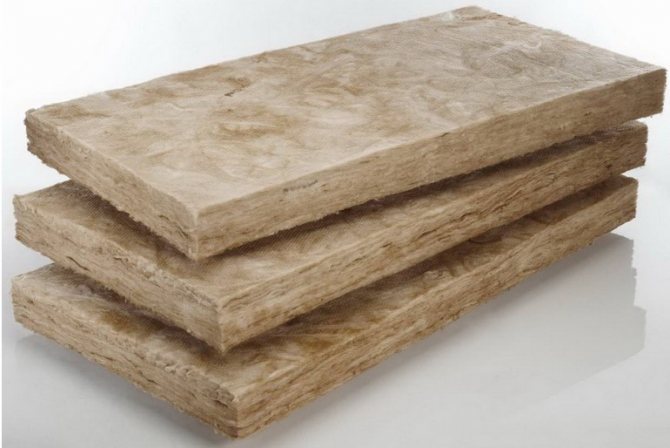

Before carrying out work, you should complete a project or make a drawing, think over a method of fastening, calculate the number of all components.
Most often, basalt mats are used at home.
Installation technology:
- it is necessary to degrease, rinse and degrease the surface of the air ducts (using acetone). Do not forget to open the windows - you can work only with sufficient supply of fresh air and as quickly as possible;
- mats are cut along the perimeter of the duct, taking into account an overlap of 100 mm;
- special glue for sticking mineral wool cloths is kneaded, protruding elements of the air duct (for example, joints, clamps) are smeared;
- first of all, protruding parts, brackets, joints are glued. the foil will be on the outside of the mat; pieces of mat are glued with an overlap of 100 mm;
- an even part of the duct is coated and glued;
- at the joints of mats and protruding parts, mineral wool slabs should have an overlap, if necessary, the joints are glued with aluminum foil;
- it is advisable (but not necessary) to secure the mats from above with wire, clamps, metal brackets.
Watch the technology in more detail on our video:
Thermal insulation of air ducts
The use of thermal insulation for air ducts makes it possible to reduce the loss of heat leaving the room to the outside through ventilation, thereby reducing heating costs. Thermal insulation is installed on the external elements of ventilation systems to limit and control heat losses.
The insulating plate is easy to cut, allowing you to cover the surface you want without overtaking. Find out more about the insulation board by visiting the link below. Lightweight insulation, very insulating and environmentally friendly, which can be used for various leveling jobs.
Insulating screws with different options
The insulation screed we install can be made with different insulation values. The thickness of the screed can also vary from 3 cm to 5 cm, depending on the detail and the customer's wishes. In addition, the base type does not play any role when you want to place an insulating screed, as the screed can also be laid on all substrates.
At various sections of the air ducts, the thermal insulation device makes it possible to solve the following tasks:
- When moving warm air flows through extended sections of ventilation systems, it is necessary to ensure that their temperature is maintained at a certain level. The type of insulation and its thickness are determined using thermal engineering calculations based on the technical operating conditions of ventilation.
- Thermal insulation is also necessary for air ducts transporting cold air. This measure is necessary to protect cold air streams from heating by warm air surrounding the ventilation ducts. In the absence of thermal insulation, the efficiency of the air conditioning system decreases significantly. Correctly arranged thermal insulation makes it possible to achieve the specified temperature regimes and ensures the compliance of the ventilation and air conditioning system without additional settings.
In order to ensure thermal insulation of air ducts of climatic systems, the following types of insulation are successfully used: materials based on basalt fiber, glass wool, foamed rubber, foamed polyethylene, most often covered with aluminum foil, foil mineral wool mats.
This insulating cover not only provides reliable insulation, but also provides a number of other attractive advantages. Thus, the screed is installed without seam and without form, and it connects well to all pipes. You will also not experience collapse as the screed is compressive resistant.
Subsequent soil insulation structure
Thus, you choose an ecological insulation solution. When the insulation is placed, we continue to insulate the floor according to your wishes. Do you still have questions about the type of insulation we use when we install floor insulation? We will help you as soon as possible!
Thermal insulation can be both internal and external, however, it makes no sense to consider the disadvantages and advantages of internal insulation - in practice, no one insulates air ducts from the inside.
The thickness of the duct insulation is determined by temperature, humidity, aggressiveness and other environmental factors. Only qualified specialists should calculate the insulation thickness. The calculation formula is specified in SNIP 2.04.14-88, which can be downloaded from the link below:
Animals that live on a roof, walls, or attic can do significant damage to your home's insulation. Contaminated insulation can pose a serious health hazard and significantly reduce a building's energy efficiency. If you are thinking of isolating or re-isolating your home or business, there are several factors to consider. The most common questions we ask are.
What is cellulose insulation?
- Is this insulation really a money saver?
- If so, what is it?
- What kind of insulation is environmentally friendly and safe for passengers?
- What are the disadvantages of maintaining current isolation?
Cellulose insulation contains over 85% recycled natural cellulose fiber from newsprint. Flame retardant injections and repellents are injected to make it the safest and most environmentally friendly insulation.
SNIP 2.04.14-88 *. Thermal insulation of equipment and pipelines. ...
